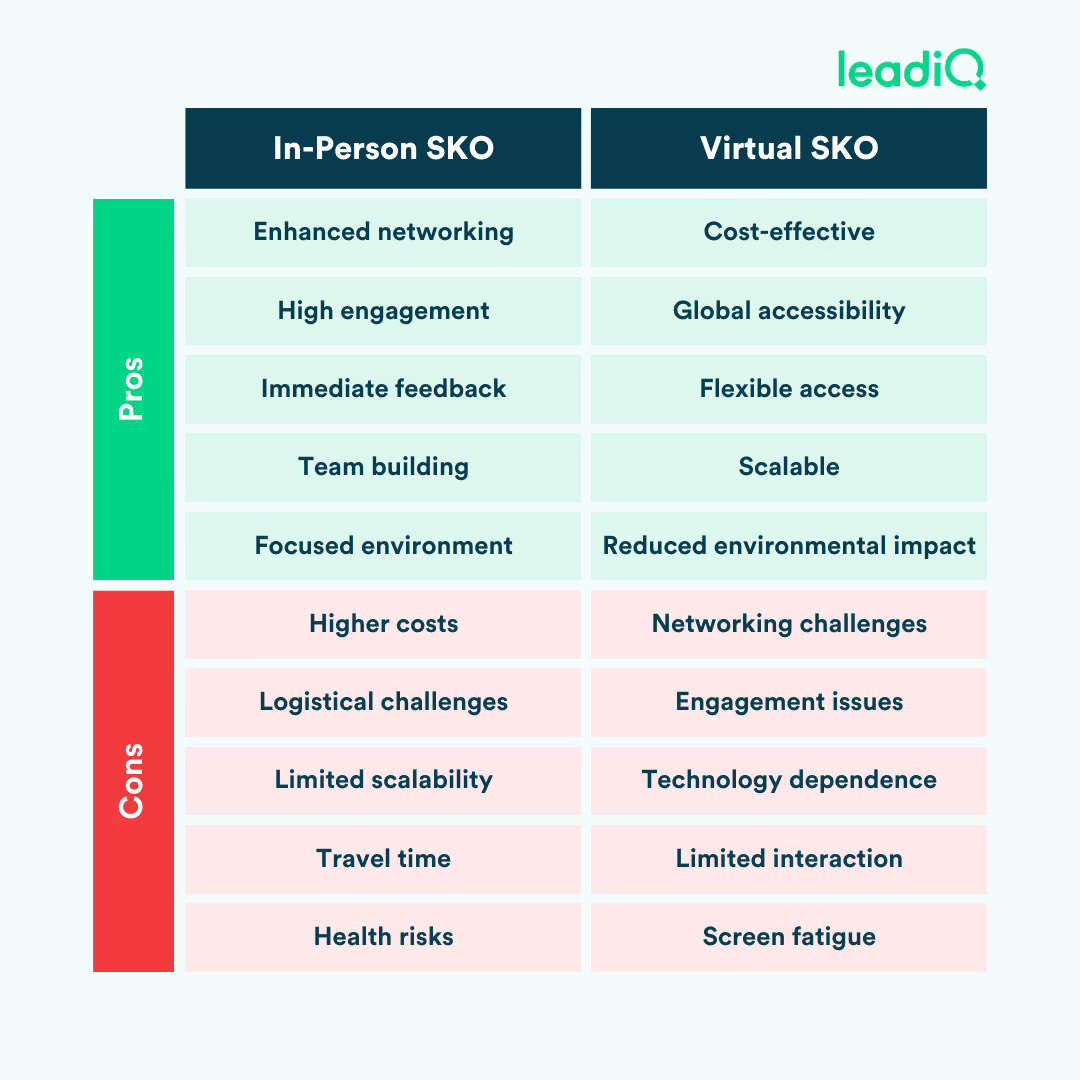Ready to create more pipeline?
Get a demo and discover why thousands of SDR and Sales teams trust LeadIQ to help them build pipeline confidently.



Effective sales kickoffs require careful pre-event planning, including setting clear objectives, choosing a format (in-person, virtual, or hybrid), and developing a tailored agenda that aligns with company goals.

ncorporating diverse presentation styles, interactive sessions, and external speakers keeps the team engaged and ensures your sales kickoff is motivating and educational.

Gathering and analyzing feedback after the sales kickoff helps identify areas for improvement and ensures future sales kickoffs are even more impactful.
Get a demo and discover why thousands of SDR and Sales teams trust LeadIQ to help them build pipeline confidently.
Planning a sales kickoff enables your team to recharge their batteries, get aligned, and build excitement for the upcoming sales cycle.
Unfortunately, you can’t decide to have a sales kickoff event and automatically expect to get the results you’re hoping for. Since the last thing you want is to plan a sales kickoff that does more harm than good, it’s important to set aside enough time for planning to ensure the event is motivating and impactful.
If you’re looking to plan a sales kickoff event that inspires your team and sets the tone for the new year, you’ve come to the right place.
Keep reading to learn more about what a sales kickoff is, tasks to take care of before and after the event to ensure success, and tips on building an exciting experience that engages your team, establishes camaraderie, and gets everyone stoked about the upcoming year.
A sales kickoff (SKO) is an event within a sales organization that marks the beginning of a new sales period.
SKOs are strategic gatherings where sales teams, RevOps, marketing, leadership, product, and other departments come together to align on goals, strategies, and initiatives for the next sales cycle. The primary objective here is to increase team alignment, motivate sales reps, and equip your team with the tools and knowledge they need to achieve sales targets.
During a sales kickoff, companies typically conduct training sessions, workshops, and presentations that cover various aspects of the sales process, product knowledge, and market trends. Together, these activities introduce new products or services to the sales team, share success stories, and reinforce the company’s sales culture.
Oftentimes, SKO events feature keynote speakers, industry experts, and company leaders who aim to inspire and energize the salesforce before they head into the field. Networking opportunities and team-building activities are also important parts of SKOs, helping build a tighter-knit team.
As LeadIQ’s COO Ben Kwon said to us at our own SKO, it's “the one time of year when everyone can get together, celebrate success, and get feedback and knowledge to improve as a team.”
That being the case, it’s important to make them as impactful as possible.
If you wait until the last minute to start sales kickoff planning, it’s unlikely that your event will be truly inspiring. When planning a sales kickoff, give yourself plenty of time to get your ducks in a row ahead of the big day(s).
Kick things off by clearly defining the objectives of your SKO and aligning them with your broader sales strategies, ensuring a cohesive vision. Clearly define specific objectives — such as improving product knowledge, enhancing collaboration, or increasing sales team motivation.
Whenever possible, take that one step further and establish SMART goals — those that are specific, measurable, achievable, relevant, and timebound — to provide clarity and create a roadmap for a successful and impactful SKO. Such goals might include growing revenue by 15%, landing 50 new clients in the upcoming quarter, or increasing customer satisfaction by 10% over the next 12 months. Once those goals are set, work backward to figure out how to best support your team in achieving them.
Your SKO theme(s) may come about organically, but more often than not you will want to define this up front and tailor your content, sessions, and activities around a single north star. What is the most important thing you, your company, and your sales team can accomplish this year?
To ensure your SKO goes smoothly, it’s important to spend time planning the logistics. First, you need to determine whether your event will be in-person, virtual, or hybrid. Assess the benefits and challenges of each format based on participant locations, company policies, budgets, and current circumstances.
If you opt for an in-person SKO, you’ll need to select a venue, figure out accommodations, and book travel arrangements. For virtual or hybrid events, select appropriate event platforms and spend some time training your team so they know how to use the tools productively.
In-person and virtual events both have their pros and cons. Ultimately, the format you choose should be based on what’s realistically possible for your organization concerning budget, resources, and geographic locations of employees.

The more stakeholders you enlist in the pre-planning phase, the more likely your SKO will help you achieve your objectives. As you begin putting together your SKO agenda, rope in representatives from multiple teams — including sales, marketing, RevOps, product, and really any person or team that can help rally the troops around your theme and objectives for the year.
For example, you might engage with sales to share insights on market trends and client needs, work with marketing to incorporate impactful messaging and branding strategies, collaborate with product teams to highlight the latest features and roadmap additions, and involve RevOps in aligning processes and metrics for success. This cross-functional approach ensures diverse perspectives, expertise, and active involvement, increasing the chances your SKO agenda is an effective one.
Send out pre-event surveys to all attendees well ahead of the sales kickoff and incorporate the data you generate into your SKO agenda. Surveys help you understand participant expectations, preferences, and areas of interest.
In a recent LeadIQ webinar, Lucas Hulleberg, former director of sales development at Labelbox, stressed the impact pre-event surveys can have on sales kickoff success. By directly asking the team what they want to hear and what topics are important to them, you can crowdsource your agenda and ensure that your SKO helps you achieve organizational goals.
“We really try to do a good job of finding opportunities, finding sessions where the entire organization could be there together but then finding times when it made sense to split off engineering from go to market,” Lucas says. We also “make sure that we’re not putting people in rooms for long periods of time where they’re listening to something that they either don’t understand whatsoever or has nothing to do with their day to day.”
By gathering insights on specific topics, training needs, and preferred formats, you can ensure your SKO agenda aligns with employee needs, which in turn increases engagement and delivers a more personalized and impactful SKO experience.
Successful SKOs are built on a foundation of strong content that keeps audiences engaged. As you begin creating content for your next SKO, keep these tips in mind to increase your chances of success.
Start by making sure the content you plan is tailored to your audience. By understanding their preferences, skill levels, and expectations, you can deliver content that resonates and adds value to their roles. Such a personalized approach to content creation ensures a more engaged and attentive audience, a more successful SKO, and — ultimately — better business outcomes.
To keep attendees involved and interested, it’s critical to incorporate a variety of different presentation styles — including workshops, keynotes, interactive breakout sessions, gamification, and pre-planned networking opportunities. Whatever you do, avoid “death by PowerPoint” scenarios and prioritize concise messaging, visual appeal, and engaging storytelling instead
While you’re at it, rope in a few external speakers to provide a broader perspective. Maybe you can land a biggish name for an inspiring talk, or maybe you can rope a customer in to sing your praises. Your team(s) likely already hear from you a lot… External speakers can add a fresh perspective that brings more value and engagement to the SKO.
Make the most out of your SKO by leveraging purpose-built tools for the occasion. For example, you can use an event app to run polls during workshops and talks and get results in real-time. Leading event apps also enable employees to ask questions digitally during each session, allowing speakers to see what the audience is interested in without breaking a stride.
While the goal of the SKO is to help your team exceed upcoming goals, the event also doubles as a fantastic opportunity for team-building. Incorporate games and challenges throughout the event — like trivia, scavenger hunts, and icebreakers — to switch things up and help your team bond with each other.
According to a recent Gallup survey, just 32% of workers are engaged. Part of the reason so many employees aren’t engaged is because many don’t feel valued by their employer.
SKOs provide the perfect opportunity to buck this trend and increase engagement by celebrating team successes openly and proudly. For the best results, just make sure you celebrate wins across all roles.
Your SKO is in the books. Congratulations! Now, it’s time to begin collecting feedback you can use to identify areas where employees may need additional support and understand what you could do to make your next SKO even better.
After your event, send out post-event surveys and facilitate discussions to find out what worked well and identify areas where employees may need additional help. Analyze the feedback to determine what kinds of resources your team might need and use it to identify actionable takeaways you can use to refine future SKOs.
At their core, sales kickoffs play a huge role in the success of your organization — or the lack thereof.
With so much at stake, it’s important to spend enough time and devote enough resources toward ensuring your SKO accomplishes what you hope it will.
To learn more about what you can do to ensure sales success in 2024 and beyond — and some tips on how to plan a successful SKO — check out our recent webinar: 2024 sales blueprint: How to prepare your GTM team for a new year.